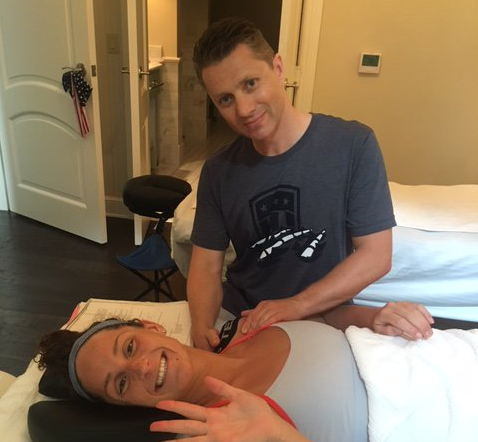What’s it like to work with Olympic swimmers like Michael Phelps?

Dr. Brian Cunningham, a physical therapist with Advocate Lutheran General Hospital in Park Ridge, Ill,. is part of the elite medical team that cares for the U.S. Olympic Swim Team. We asked him a few questions to learn more about him and his work with our Olympic swimmers.
Can you tell us a little bit about yourself?
I grew up swimming in Limerick, Ireland. I swam through high school and came to the United States after getting my degree in physical therapy. I swam Masters for 15 years, but sustained a shoulder injury which led to two shoulder surgeries. After that happened, I vowed that I would help prevent this from happening to others.
As far back as I can remember, I would always watch the Olympics and thought to myself, “how can I possibly get to that level?” I admire the work of the Olympians, and I love to see people at the pinnacle of their athletic careers.
How difficult was it to get on the Olympic medical team?
I joined USA Swimming Sports Medicine and Science Committee with the hope of learning the most up-to-date assessment and treatment techniques for swimmers. That’s where I learned about the opportunities to work with elite swimmers and embarked on my journey.
The selection procedure was rigorous. It started in 2009 after I completed my doctorate in physical therapy, which was a necessary requirement to be considered by the United Stated Olympic Committee (USOC) for Olympic and Paralympic events. Being competitive, I decided to test my skills and began the screening process at United States Olympic Training Center in Colorado Springs, where for two weeks I got to staff the 24-hour medical clinic for their athletes. This served as an opportunity for USOC to evaluate my skill set and assess my interaction with the athletes. USOC officials also saw what style of care I offered and how I worked with a multidisciplinary team of physicians, chiropractors, athletic trainers and massage therapists.
From there, I was assigned to USA Swimming, where the selection process continued. Initially, I was assigned to local meets, and then I progressed to higher level meets, such as national and international competitions like the World University Games and World Championships. Working at different levels of competition exposed me to different levels of athletes, many of which were elite level swimmers and coaches. This exposure helped me understand their health needs.
Based on recommendations from all the coaches and the swimmers I’ve interacted with over the years, I applied to and was selected to be part of the Olympic staff. So as you can see, it requires both long-term personal and professional commitment to the sport. It was worth every moment!
What is your role?
My role is to serve the athletes’ health needs and help them perform to the best of their ability. Each staff member brings a different set of skills to the team to help athletes perform at the highest level. Having been around the swimmers for many years, I’ve become accustomed to what works and what doesn’t for each. This allows the athletes to trust me and my manual therapy skills.
What is it like to help them train?
It’s a huge honor, and I am truly blessed to have this opportunity to work behind the scene with the athletes. It feels great to contribute to the overall success of these athletes and to be a small part of team USA. The intensity at which swimmers train is phenomenal, and their ability to make minute adjustments is spectacular. I equate it to driving a Lamborghini. You need to truly understand each swimmer’s tissues’ response to training in order to determine what is a normal response and one which is an abnormal response and make adjustments with your manual treatments accordingly, making sure not to over-treat the area so as not to have the athlete become concerned about their ability to function. Generally, injuries are from overuse such as tendinitis of the shoulder, but also we see low back pain.
What are some of the challenges?
The biggest challenge is to treat pain and injury in the moment and to determine what type of physical and psychological support they need at that time in order for them to achieve their true potential. Because the athletes do not want to lose any time, you are under a lot of pressure to resolve the issues as soon as possible, which can be very nerve-racking, but exciting at the same time.
Another challenge is to support the athletes in making time adjustments necessary for live coverage during the Olympics. Swimmers are retraining themselves to swim later at night and wake up later than usual. They have to do small things differently, like eating at different times in order to prepare for finals, a lot later than they would normally. After finals, they have to do interviews, drug testing, warm downs and refuel. It could be 2 a.m. before I can see them for a post-race massage. So with all of these demands, the coaches and the medical staff have to learn how the athlete is adjusting and address any signs of fatigue or strain to their routine in order to prevent injury and maximize performance.
Related Posts
Comments
One Comment
About the Author
Sonja Vojcic, health enews contributor, is a marketing manager at Advocate Health Care in Downers Grove, Ill. She has several years of international public relations and marketing experience with a Master’s degree in Communications from DePaul University. In her free time, Sonja enjoys spending time with her family, travelling, and keeping up with the latest health news and fashion trends.


















Wonderful story on an exceptional therapist who strives to be the best. Enjoyed the article and the Olympics. GO USA!!!!